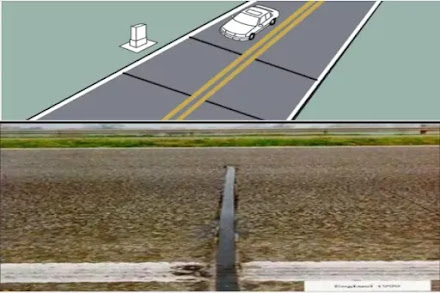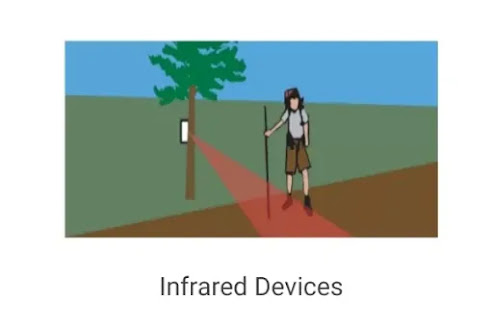TRAFFIC VOLUME STUDY
Traffic volume (flow) is variable. It is of great importance to the traffic engineer. It is essentially the quantity of movement per unit of time at a specified location. The quantity of movement may be either of single traffic unit-pedestrians, cars, buses or goods vehicles, etc. The time period will depend on the purpose of the study. in this article, we will study how to carry out a traffic volume study?
 |
Traffic Volume
The number vehicles crossing a section of road per unit time at any selected period is called traffic volume And study of traffic volume is known as a traffic volume study.
The unit of traffic volume is vehicles per hour or vehicles per day.
Objects and uses of traffic volume study :
1. Traffic volume study is accepted as a true measure of the relative importance of roads and in deciding the priority to improvement and expansions.
2. Traffic volume study is used in planning, traffic operation and control of existing facilities.
3. Used in planning and designing the new facilities.
4. For the analysis of traffic patterns and trends.
5. Classified volume study is useful in ‘structural design of pavements, in geometric design and in computing roadway capacity.
6. For planning sidewalks, crosswalks, subways, etc.
7.Turning movement study used in the design of intersections in planning signal timings, etc.
8. To know the various types of the vehicle using the road.
The following studies are carried out in the traffic volume study
1. Classification of traffic, i.e. buses, trucks, cars, auto-rickshaws, cycles, bullock carts, pedestrians, etc.
2. Number of vehicles in each class.
3. The direction of each class of traffic flow is also noted.
4. At intersections, the traffic flow in each direction of flow including turning movements is recorded.
5. The peak traffic period is also noted.
TYPES OF VOLUME COUNTS
Hourly traffic volumes and average daily volumes are those commonly used in the planning, design, and operation of highway facilities. Traffic demands in the vehicle per hour per lane are of great significance in dealing with practical traffic problems.
1. Peak Hour Volume (PHV) or Peak Hour Flow (PHF):
The highest hourly volume in a day is called peak hour volume. It is the maximum number of vehicles that pass a point on a highway during one hour.
There is one peak in the morning and another in the evening referred as ‘morning peak hour’ and ‘evening peak hour’.
It is used for,
1. Functional classification of highways (dike arterial, sub-arterial, collector, and local streets for urban roads).
2. The geometric design of highway (like the number of lanes, intersection signalization, channelization, etc.)
3. capacity analysis
4. Parking demands and regulations.
5. Planning and location of traffic control devices, (traffic signs, signals, markings)
6. Location of interchanges.
2. Average Annual Daily Traffic (AADT) :
It is the average of 24 hours volume count collected every day in the year.
It is useful for;
1.Planning major streets
2.Improvement, construction, or reconstruction of roads
3.Estimating highway user revenue
3. Average Daily Traffic (ADT) :
The total volume during a certain number of days, divided by that number of days is called average daily traffic.
Fig. Shows the typical traffic pattern throughout the day, week, and the year.
 |
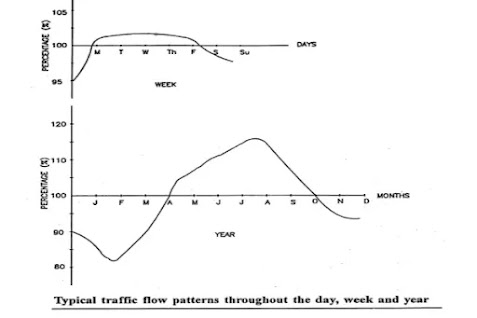 |
4. Classified volumes :
These are used for,
1.Geometric design with respect to minimum turning paths, clearance, grade
2.Structural design of pavements, bridges.
3.Estimating highway user revenues.
4. Short counts less than an hour :
5. Short counts less than an hour :
These are used for,
1. Analyzing maximum rates of flow and, variation within the peak hour
2. Providing economical means of obtaining volume data.
3. Determining capacity limitations in urban areas.
6. Cordon count volumes :
These are made for,
1.Planning parking facilities
2.To obtain accumulation of vehicles inside the cordon area.
7. Pedestrian volumes :
These are utilized in planning the crosswalks and signals for pedestrians.
8. Turning movements counts :
These are used in
1.Design of intersection and interchanges
2. Planning of signal timings
3. Planning turn prohibitions
4.Channelization, etc.
METHODS OF TRAFFIC VOLUME STUDY
COUNTING OF TRAFFIC VOLUME STUDY :
The traffic volume study counts may be done by mechanical counters or manually.
(A) Mechanical Counters (Automatic Counters) :
These may be either fixed (Permanent) type or portable type. The mechanical counter can automatically record the total number of vehicles crossing a section of the road in the desired period. The working maybe by the effect of impulses or stimuli caused by traffic movements on a pneumatic hose placed across the roadway.
Advantages :
1.It can works throughout the day and night for the desired period, recording the total hourly volume.
2. It does not require any supervision
3.It is suitable for long counts.
Disadvantages
1.It is not possible to get the traffic volume of various classes of traffic.
2.It does not give the details of turning movements.
3.The impulses caused by light vehicles may not be enough in some cases to acute the counter.
4.It is not possible to record the pedestrian traffic.
Types of Automatic Counters :
Various types of automatic counters are :
1.Pneumatic tube (road tube)
2.Electric contact device
3.Co-axial cable
4.Photo-electric device
5.Radar
6.Infra-red device
7.Magnetic device
8.Ultrasonic device
(1) Pneumatic tube (Road tube) :
A thick walled flexible tube (10-12 mm diameter, 3 mm thick) with one end sealed is clamped to the road surface at right angles to the pavement. The other end of the tube is connected to a diaphragm or counter. At the sealed end a small air release hole is provided to avoid bounced impulses. As a vehicle wheel crosses the tube it compresses it, causing an air ‘shock wave’ to travel along the tube, operating a simple ‘make and break’ circuit of the counter as shown below.
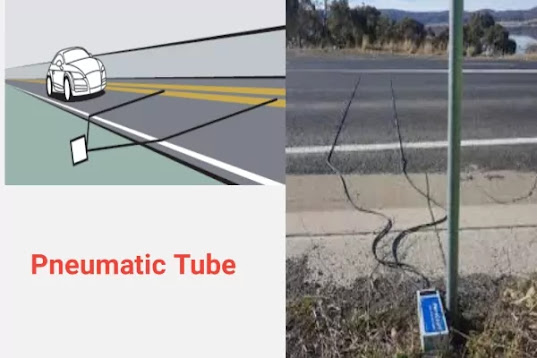 |
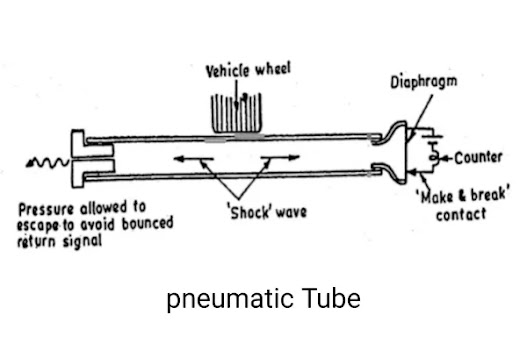 |
(2) Electric contact device :
A pair of steel strips are contained in a rubber pad which is burried beneath the road surface. On being pressed by the weight of a moving axle the steel strips come into contact with each other and cause the electric current to flow. Electric contacts are installed in each lane.
 |
||
|
(3) Co-axial cable :
A coaxial cable is clamped across the road surface with the capability of generating signals with the passage of axles. These signals actuate a transistorized counter. The advantages associated with this type of detectors are their better reliability and performance on inferior type of surfaces and their lesser susceptibility to damage.
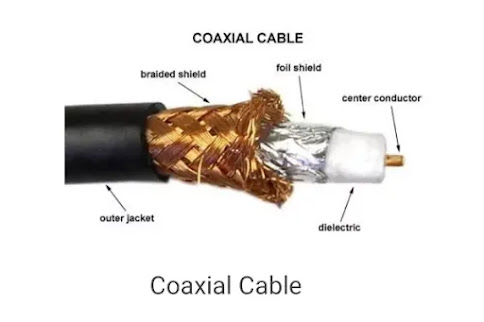 |
(4) Photo-electric device :
On one end of the road is a source of light which emits a beam across the road. At the other end is a photocell which can distinguish between the light beam and absence of the light beam. The passage of vehicle in the path of the light beam obstructs the beam and causes detection by the photo cell.
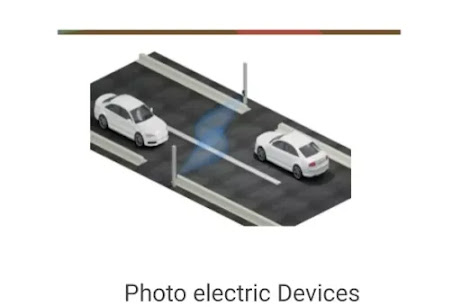 |
The difficulty is that obstruction can be caused by pedestrians and that more than one vehicle in the different traffic lanes, will register only one vehicle.
(5) Radar :
Doppler effect is a well-known phenomenon in physics which enables the detection of vehicles moving at a speed. When a moving object approaches or recedes from the source of signals, the frequency of the signal received back from the moving the object will be different from the frequency of the signal emitted by the source. This difference in the two frequencies causes the detection of a moving vehicle. The initial cost of this device is no doubt high, but its accuracy and reliability are good. It is also not damaged by traffic.
 |
(6) Infra-red device :
This device utilities a pick-up cell, which is similar to a photoelectric cell, but is sensitive to infrared (heat) radiation, rather than to visible light. The unit is mounted above the road surface on a bridge or sign structure etc.
 |
||
|
(7) Magnetic device :
In this, detection is done by a signal or impulse caused by a moving vehicle and disturbing a magnetic field. The unit is installed in each lane immediately below the road surface. It is more durable but more expensive than a pneumatic detector.
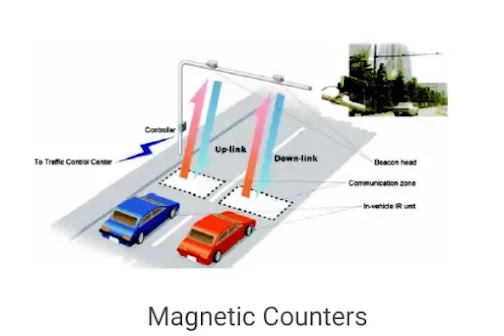 |
(8) Ultrasonic device :
This is similar in its operation to a radar unit. A beam crosses the road and is broken by the passage of a vehicle.
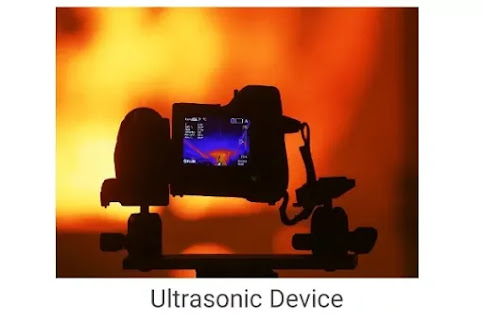 |
(B) Manual Counts :
In this method, the members of field team collect the necessary information on the prescribed record sheets at the selected points of roadway.
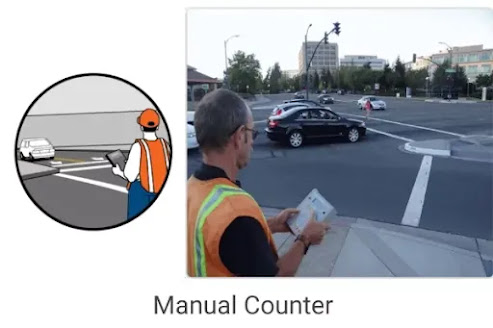 |
Advantages :
1. It gives a classified volume of each category of traffic, namely, buses, cars, trucks, auto-rickshaws, cycles, scooters, pedestrians, etc. which can not be collected by mechanical counters.
2. The direction of each class of traffic at intersection is also be recorded.
3. The number of occupants in vehicles are also recorded in this method.
Disadvantages :
1. It is not possible to have manual counts for all the 24 hours of the day and on all days round the year.
2. It is tedious, laborious and costly.
MOVING OBSERVER METHOD [FLOATING CAR METHOD]
This method is also known as Wardrop Charlesworth method. It was developed in England. This method consists in counting the number of cars met, number of cars overtaken, and the time taken to travel by the observer, once moving against the traffic and once moving along with the traffic.
The floating car method is generally followed in India. Here we have a test car with four observers in it which is floating, i.e. which is travelling at approximately the same speed as that of the traffic.
![MOVING OBSERVER METHOD [FLOATING CAR METHOD] ,traffic volume study TRAFFIC VOLUME STUDY, how to carry out traffic volume study ?](https://1.bp.blogspot.com/-51o_TCw63Vs/X2Ha5Lr7s4I/AAAAAAAAETo/iSbqVPUQFuAJJhEpSprRmEH4ECrxhg7XQCLcBGAsYHQ/w497-h331/Moving%2Bobsever%2Bmethod.webp) |
The first observer equipped with two stopwatches is an observer to record delays. At strategic locations such as bridges, intersections, roads in the vicinity of markets etc. he observes with the help of two stopwatches the time required to negotiate these focal points, i.e. he observes the delay time.
The second observer in the car notes the cause of this delay either in the tabular form or with vivid descriptions.The third observer record the number of vehicles overtaken by the floating car or the number of vehicles that overtakes the floating car, in specified time.
The fourth observer notes the number of vehicles traveling in opposite direction in each trip.
Advantages of the method :
(i) The moving observer method gives an unbiased estimate of the flow.
(ii) As compared to the stationary observer method, the moving observer method is equivalent to a stationary count over twice the single journey time. Hence it is economical in manpower.
(iii) It gives mean values of flow and speed over a section, rather than at a point. Thus it gives directly the space mean speed, whereas spot speed studies give the time-mean speed.
(iv) It gives additional information on stops at intersections, delays, parked vehicles, etc.
(v) It enables data on speed and flow to be collected at the same time.
VIDEOGRAPHY METHOD FOR TRAFFIC VOLUME STUDY:
The videography is carried out for the stretch of road about 20 to 30 m. The entry and exit of the vehicle on the selected approach should be covered in the videography. The start time of the video is set to zero. The movement of the vehicles are recorded for an hour. After the end of the videography, the vehicles are counted on the screen of the computer or DVD. The entry time of the vehicle and exit time of the vehicle is recorded for the vehicles on the selected stretch.
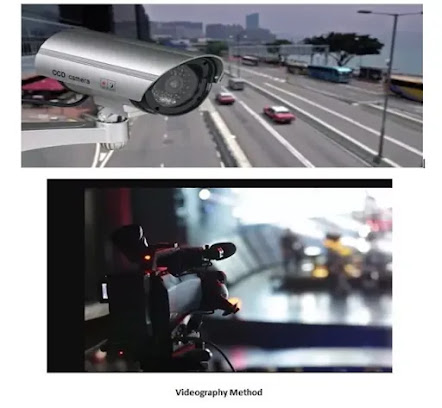 |
The distance passed by the vehicle per unit time is worked out.Video photography gives a permanent record of volume counts. Its analysis can be done conveniently in the office by replaying the cassette on a TV monitor.
PASSENGER CAR UNITS (PCU) FOR TRAFFIC VOLUME STUDY:
Different classes of vehicles such as cars, buses, trucks, autorickshaws, scooters, cycles, bullock carts, etc. are found to use the common, roadway facilities without segregation on most of the roads. Such a traffic flow is called heterogeneous traffic flow or mixed traffic flow.
The different vehicle classes have a wide range of static characteristics such as length, width, etc. and dynamic characteristics such as speed, acceleration, etc. It is rather difficult to estimate the traffic volume and traffic capacity of roadways under mixed traffic flow.
It is a common practice to consider the passenger car as the standard vehicle unit to convert the other vehicle classes and this unit is called Passenger Car Unit (PCU).
PCU =Capacity of roadway with passenger cars only/Capacity of the roadway with that class of vehicle
PCU indicates the space required for a vehicle on a road. For example,
PCU for the car is 1 and that for the bus is 3, it means the space required for a bus on the road is three times more than that required for a car.
PCU values for different classes of vehicles as per IRC : 64-1990 are given in the table .
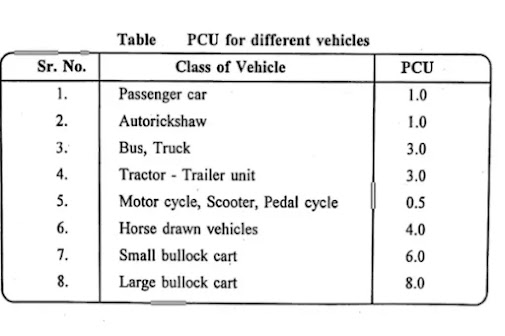 |
Factors affecting PCU :
The various factors affecting PCU of vehicle class related with vehicle, traffic stream,
roadway and control conditions are listed below :
(a) Vehicle Characteristics :
■ dimensions (length, width etc.)
■ power
■ speed
■ acceleration and braking characteristics
(b) Traffic stream characteristics :
■ Gap (transverse and longitudinal) between moving vehicles.
■ Composition of different vehicle classes
■ Mean speed and speed distribution.
■ Ratio of volume to capacity of the road.
(c) Roadway characteristics :
■ Road geometries (including gradient and curves)
■ access control
■ rural/urban
■ intersections (number and type)
(d) Control of traffic :
■ Speed limit
■ One-way street operation
■ Traffic control devices (signs, markings, signals etc.)
From the above factors, it is seen that PCU value of a particular vehicle class cannot remain a constant value. It is a dynamic value changing with roadway, traffic and control conditions. Out of the above factors, the most significant factors are size (Length and width) of vehicle, average speeds of traffic stream and gap (transverse and longitudinal) between the vehicles.
I Hope You Like Our Article “TRAFFIC VOLUME STUDY: How To Carried Out 10 Traffic Volume Studies In Traffic Engineering” Don’t be Cheap To Share This Article with your Friends.


